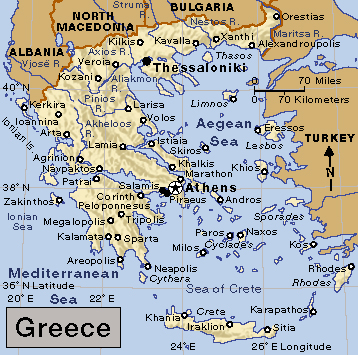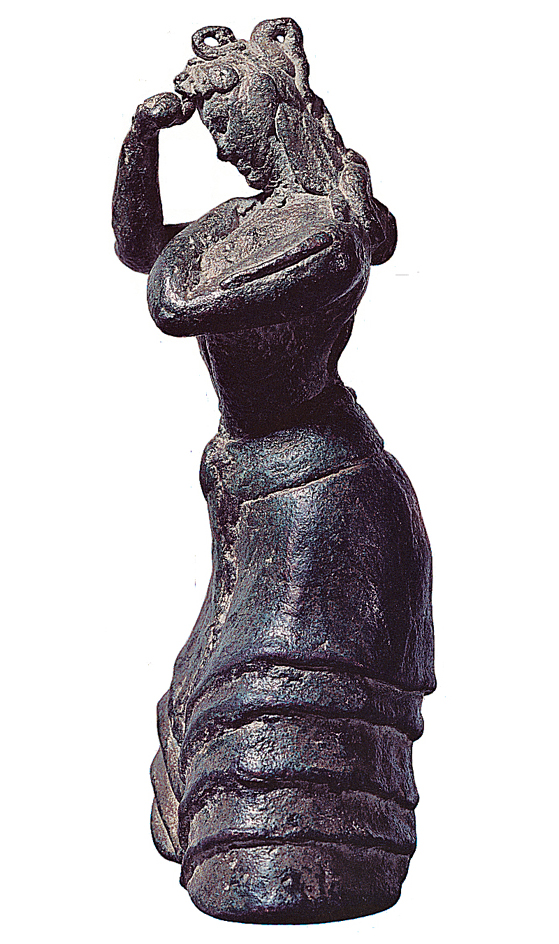Crete, << kreet >> (pop. 624,408), is the largest Greek island. It lies in the Mediterranean Sea, about 60 miles (97 kilometers) south of the mainland of Greece. Crete was the birthplace of one of the first European civilizations, the Minoan culture. This civilization began about 5,000 years ago.

Crete covers 3,219 square miles (8,336 square kilometers). Iraklion is Crete’s capital, largest city, chief port, and commercial center.
People.
About half of Crete’s people live in the island’s three largest cities: Iraklion, Khania, and Rethimnon. Cretans speak Greek, and most belong to the Greek Orthodox Church. Cretans are proud of their past and follow many old customs. For example, people in rural villages perform traditional dances and folk songs in folk costumes. These activities occur chiefly during celebrations of weddings, baptisms, or religious holidays. However, most aspects of Cretan life, such as education and employment, are similar to those of mainland Greece.
Loading the player...Greece: folk dance from Crete
Cretans often gather in cafes for such purposes as eating, playing backgammon, and discussing politics. Social life in Crete’s cities becomes especially active during the cool summer evenings.
Land and climate.
A chain of mountains extends across the center of Crete in an east-west direction. The highest point is Mount Ida, which rises 8,058 feet (2,456 meters) above sea level in central Crete. Fertile valleys and plains lie among the mountains, which drop off sharply to the sea along most of the southern coast. The mountains slope more gradually in the north, and a narrow plain extends along the northern coast.
Crete has a mild, dry climate. Temperatures average 53 °F (12 °C) in winter and 75 °F (24 °C) in summer. Rain falls chiefly from October to March and is heavier in the mountains than on the plains and valleys. A number of Crete’s farming areas require irrigation because they do not get enough rain.
Economy.
Tourism is an important part of Crete’s economy. Each year, hundreds of thousands of tourists visit Crete to see the ancient Minoan ruins at Knossos and Phaistos and the Minoan relics at the Archaeological Museum in Iraklion.

Agriculture employs a large number of Cretans. The main crops include carobs, citrus fruit, grapes, and olives. Most of Crete’s manufacturing takes place in the northern coastal cities. Factory products include processed food, building materials, chemicals, paper, and textiles.
Government.
Crete is governed by the central Greek government in Athens. The island is divided into four nomoi (also called prefectures), each headed by a nomarch (governor) appointed by the minister of the interior.
History.
The first people to settle in Crete came from Asia Minor (now part of Turkey) about 6000 B.C. By about 3000 B.C., the Cretans had developed an advanced civilization. It is called the Minoan culture, after the legendary King Minos (see Minos). During the Minoan period, the Cretans made great advances in art, architecture, and engineering. They built beautiful palaces with spacious courtyards. They excelled at making pottery and jewelry and also used a system of writing. For more information, see Aegean civilization (The Minoan culture).

Fire destroyed many towns and palaces of Crete after about 1450 B.C., and the civilization gradually declined. The Romans invaded the island in 68 B.C. and made it a province in 66 B.C. After the division of the Roman Empire in A.D. 395, Crete came under Greek rule as part of the Byzantine Empire. Venice ruled the island from 1204 to 1669. The Ottoman Empire conquered Crete and ruled it from 1669 to 1898.
A movement for union with Greece developed in Crete during the 1800’s, and Crete became part of Greece in 1913. German forces conquered Crete in 1941, during World War II. The Germans controlled the island until several months before the war ended in 1945. After the war, Crete greatly improved its roads and tourist facilities. Today, it ranks as a major attraction for visitors to Greece.
